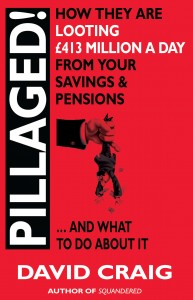You probably don’t know what a G-SIFI is. I first saw the acronym about a week ago. But unless our rulers are very careful indeed, soon journalists will be talking and writing about little else.
A G-SIFI is a “Globally active, Systemically Important, Financial Institution” – basically a big bank or insurance company. So, what’s the problem with these G-SIFIs? The problem is that many G-SIFIs have made massive loans to countries that are to all intents and purposes bankrupt. French G-SIFIs are exposed to $489bn of loans to countries like Spain, Italy, Portugal and Greece; German G-SIFIs have at least $572bn of loans to dodgy countries on their books: UK banks are exposed to over $529bn: and so on – you probably get the picture.
But why are these loans unlikely ever to�be paid back? Because most of the countries who have borrowed this money are in a downward spiral where austerity measures lead to economic contraction leads to lower tax revenue and higher social spending lead to higher debt leads to higher interest payments lead to more austerity, leads to economic contraction leads to………. Most of these countries have already had one or even two bailouts. Yet�their downwards spiral continues. Unless there is economic growth soon, something pretty horrible is going to happen.
Greece was a minnow. So, holders of Greek bonds losing some of their money didn’t cause too many waves amongst the G-SIFIs. But if Spain or Italy get into trouble and bondholders have to take a “haircut”, then one or more G-SIFIs may go bankrupt and that’s when the proverbial really hits the fan.
Our leaders are already preparing for some G-SIFI� bailouts. The Bank of England have a plan called�”Resolving Globally Active, Systemically Important, Financial Institutions”. According to this plan, in the event of a G-SIFI going down, shareholders and depositors will pay for the bailout. Meanwhile the EU has issued a directive – “The Recovery and Resolution Directive” – which cancels deposit insurance on the first �100,000� (�85,000 in the UK) of savers’ money. So, if we have any money in a G-SIFI that collapses, we risk losing everything. And anyway, who owns the shares in G-SIFIs? Mostly pension funds. So, if a G-SIFI explodes, we can be hit twice – once through losing our savings and secondly through the money our pension fund loses. If a G-SIFI goes down, there’s only one certainty – the big bosses will all walk away from the smoking ruins with tens of millions in their pockets.
The moral of the story is never put more than you can afford to lose in any one major G-SIFI.�Moreover, if you do a major transaction, like selling a house, as soon as you get the money, split it between a few banks.
Am I being alarmist? Yes. Will a G-SIFI collapse? Yes. And when a G-SIFI does implode, will all the experts say this was totally unexpected? Yes. And when our leaders steal our savings to bail out the bankrupt G-SIFI, will we be told this is a “one-off” and an “exception” and that there’s no need to withdraw our money from other G-SIFIs? Yes.
(btw – I’m only selling about one copy a week of my latest book GREED UNLIMITED. That’s hardly impressive. So I’d be grateful if some readers of this blog could give some support by buying GREED UNLIMITED)














Why not GASIFI?
Sort of sounds like the vaporization of any residual solidity in the global banking system, as our ‘guaranteed’ deposits evaporate in a cloud of smoke, and the only sooty residue is bankster bonuses.
(btw � I�m only selling about one copy a week of my latest book GREED UNLIMITED. That�s hardly impressive. So I�d be grateful if some readers of this blog could give some support by buying GREED UNLIMITED)
You need to get yourself on the Keiser Report.
You’ll sell loads
[…] […]